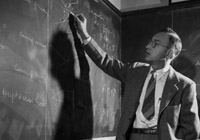
The Taub cluster is named in honor of Abraham Haskel Taub (1911-1999), who was chief mathematician for the original ILLIAC project and director of the Digital Computer Laboratory from 1961 to 1964.
Taub was born in Chicago, where he attended public schools and graduated from the University of Chicago in 1931. He then pursued graduate study at Princeton University, completing his PhD in mathematics in 1935 with a thesis on mathematical cosmology under the direction of noted relativity theorist Howard P. Robertson. Taub remained at Princeton for an additional year as a postdoctoral fellow at the Institute for Advanced Study, where he worked with the brilliant mathematician and computer pioneer John von Neumann. Taub then took a faculty position in mathematics at the University of Washington, where he remained until returning to Princeton to pursue defense-related research on shock waves during World War II, for which he received a Presidential Certificate of Merit in 1946.
Taub’s practical research during the war and the influence of John von Neumann led to his interest in the nascent field of digital computers. Taub came to the University of Illinois in 1948 to help build the ORDVAC computer based on von Neumann’s design, which was delivered to the U.S. Army’s Aberdeen Proving Ground in 1952. The spirit of the times is well captured by the following anecdote, recounted by Sylvian Ray in No Boundaries: University of Illinois Vignettes (University of Illinois Press, 2004):
When ORDVAC was completed, it was tested at the University of Illinois and then disassembled and shipped to Aberdeen Proving Ground in Maryland. Three faculty members including Sylvian Ray and Abe Taub drove to Maryland to help assemble the machine, which was reconstructed and passed its validation tests in just a week. It was expected that assembly and testing would take over a month. When some military officers came to check on the progress of the assembly, they asked, “Who is in charge here?” and were told, “It’s the guy holding the broom!” as Abe Taub—the head of DCL—was sweeping up after having completed all the necessary tasks.
The same team built a twin version of ORDVAC, dubbed ILLIAC, that remained at Illinois, becoming the first digital computer wholly built and owned by a university in the United States. It remained in service until 1962 when it was replaced by ILLIAC II. ILLIAC I was used to compose the Illiac Suite, one of the first suites of computer music, and also served as the basis for PLATO, the first computer-based education system, which pioneered such current concepts as flat plasma displays, email, computer games, and online communities.
While at Illinois, Taub served as doctoral advisor for a number of graduate students, including three who went on to distinguished careers in scientific computing: Robert T. Gregory, Gene H. Golub, and C. William Gear.
Taub left Illinois to become director of the Computer Center (1964-1968) at the University of California, Berkeley, with a mandate to establish a Computer Science Department, which came into being in 1967. Taub also served as professor of mathematics until his retirement in 1978 and then as emeritus professor until his death in 1999.
Additional biographical information: Princeton, Berkeley, SIAM.
